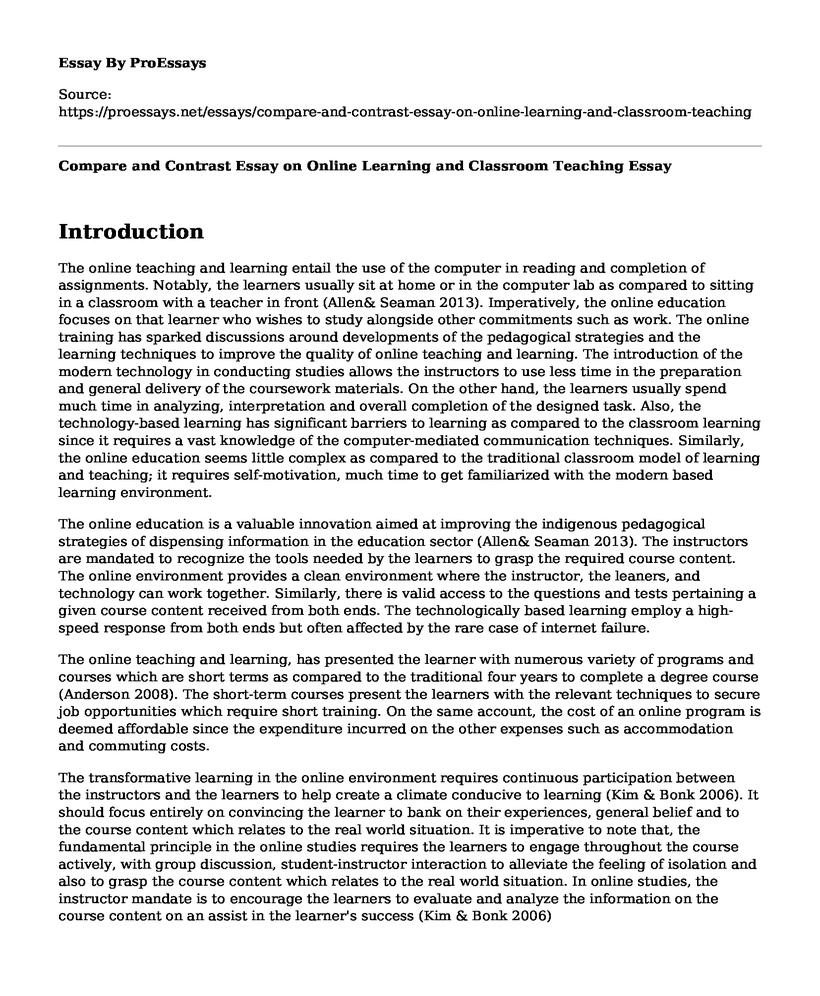Introduction
The online teaching and learning entail the use of the computer in reading and completion of assignments. Notably, the learners usually sit at home or in the computer lab as compared to sitting in a classroom with a teacher in front (Allen& Seaman 2013). Imperatively, the online education focuses on that learner who wishes to study alongside other commitments such as work. The online training has sparked discussions around developments of the pedagogical strategies and the learning techniques to improve the quality of online teaching and learning. The introduction of the modern technology in conducting studies allows the instructors to use less time in the preparation and general delivery of the coursework materials. On the other hand, the learners usually spend much time in analyzing, interpretation and overall completion of the designed task. Also, the technology-based learning has significant barriers to learning as compared to the classroom learning since it requires a vast knowledge of the computer-mediated communication techniques. Similarly, the online education seems little complex as compared to the traditional classroom model of learning and teaching; it requires self-motivation, much time to get familiarized with the modern based learning environment.
The online education is a valuable innovation aimed at improving the indigenous pedagogical strategies of dispensing information in the education sector (Allen& Seaman 2013). The instructors are mandated to recognize the tools needed by the learners to grasp the required course content. The online environment provides a clean environment where the instructor, the leaners, and technology can work together. Similarly, there is valid access to the questions and tests pertaining a given course content received from both ends. The technologically based learning employ a high-speed response from both ends but often affected by the rare case of internet failure.
The online teaching and learning, has presented the learner with numerous variety of programs and courses which are short terms as compared to the traditional four years to complete a degree course (Anderson 2008). The short-term courses present the learners with the relevant techniques to secure job opportunities which require short training. On the same account, the cost of an online program is deemed affordable since the expenditure incurred on the other expenses such as accommodation and commuting costs.
The transformative learning in the online environment requires continuous participation between the instructors and the learners to help create a climate conducive to learning (Kim & Bonk 2006). It should focus entirely on convincing the learner to bank on their experiences, general belief and to the course content which relates to the real world situation. It is imperative to note that, the fundamental principle in the online studies requires the learners to engage throughout the course actively, with group discussion, student-instructor interaction to alleviate the feeling of isolation and also to grasp the course content which relates to the real world situation. In online studies, the instructor mandate is to encourage the learners to evaluate and analyze the information on the course content on an assist in the learner's success (Kim & Bonk 2006)
Conclusion
The in-depth analysis reveals that the online studies are more interactive as the learners are fully engaged in the learning without the destruction from the other learners and other classroom activities (Anderson 2008). The sessions are interactive and higher concentration ability according to the learners. The online education also allows career advancement to the learners who intend complete their studies while working.
References
Allen, I. E., & Seaman, J. (2013). Changing course: Ten years of tracking online education in the United States. Sloan Consortium. PO Box 1238, Newburyport, MA 01950.
Anderson, T. (Ed.). (2008). the theory and practice of online learning. Athabasca University Press.
Kim, K. J., & Bonk, C. J. (2006). The future of online teaching and learning in higher education. Educause Quarterly, 29(4), 22-30.
Cite this page
Compare and Contrast Essay on Online Learning and Classroom Teaching. (2022, Jun 06). Retrieved from https://proessays.net/essays/compare-and-contrast-essay-on-online-learning-and-classroom-teaching
If you are the original author of this essay and no longer wish to have it published on the ProEssays website, please click below to request its removal:
- Personal Request of a Better Grade
- Child Behavioral Health Essay
- Advanced Health Assessment for Nurse Educators Essay
- Essay Example on My Nursing College Dream: Providing Excellent Care & Tech Knowledge
- Critical Thinking as the General Education Outcome
- Essay on Inclusive Education: Achieving Social & Academic Success for Children With Disabilities
- Essay Example on Team-Based Learning: A Constructivist Approach







